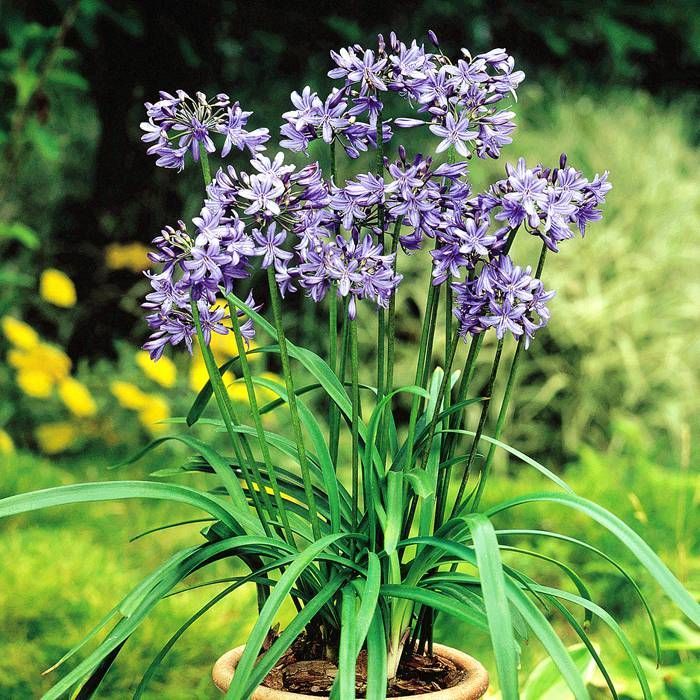Common Agapanthus Troubles and How to Address Them
Wiki Article
Unleashing the Secret to Successful Agapanthus Growing: Advice for a Flourishing Garden
In the realm of gardening, cultivating agapanthus successfully needs a tactical technique that encompasses numerous facets of plant care. By recognizing the subtleties of agapanthus farming, one can create a setting where these plants thrive and grow abundantly.Planting Agapanthus: Finest Practices
When planting Agapanthus, correct dirt preparation is essential for making certain successful growth and advancement of these stunning flowers. Agapanthus, frequently called Lily of the Nile or African lily, thrives in well-draining dirt with a slightly acidic to neutral pH level - Agapanthus. Prior to growing, it is crucial to modify hefty clay soils with raw material such as garden compost or peat moss to boost drainage and supply vital nutrients for the plantsTo plant Agapanthus, choose an area that gets full sunshine to partial shade, as this will certainly promote healthy development and plentiful blooming. Dig an opening two times the diameter of the plant's origin sphere and place the Agapanthus at the same depth it was previously expanding. Delicately backfill the hole with dirt, weighing down securely to get rid of any air pockets around the origins.
Water the freshly planted Agapanthus completely and remain to maintain the dirt evenly wet, especially during the plant's energetic growing period. Agapanthus. Applying a balanced plant food once a month can better support the plant's growth and flowering. By adhering to these ideal practices for planting Agapanthus, you can produce a sensational display screen of these fascinating flowers in your garden
Ideal Soil Issues for Agapanthus
For optimum growth and growing success of Agapanthus plants, making certain the dirt conditions are ideal is essential. Agapanthus prefers soil that is abundant in nutrients, so including a balanced fertilizer throughout the expanding period can advertise healthy and balanced growth and lively blooms.
Watering and Fertilizing Tips
To make certain healthy and balanced development and lively blossoms, appropriate watering and feeding strategies are vital for effective Agapanthus cultivation. Agapanthus plants benefit from normal watering, specifically throughout the growing season.When it involves feeding Agapanthus, a balanced fertilizer with equivalent components nitrogen, phosphorus, and potassium can be used in the springtime to promote healthy development and blooming. Slow-release fertilizers are perfect for offering go to this site nutrients gradually over an extensive period. Prevent over-fertilizing, as this can result in extreme vegetation growth at the expense of blooms.
In addition, integrating raw material like garden compost into the dirt can improve nutrient levels and improve dirt structure, helping in the overall wellness of the Agapanthus plants. By complying with these watering and fertilizing pointers, gardeners can guarantee their Agapanthus plants grow and produce spectacular display screens of flowers.
Trimming and Deadheading Methods
Correct pruning and deadheading strategies play a crucial function website here in keeping the health and wellness and aesthetic appeals of Agapanthus plants, complementing the necessary methods of watering and feeding for effective growing. Pruning Agapanthus includes eliminating spent flower heads, dead or yellowing fallen leaves, and overall shaping of the plant to advertise better growth. Deadheading, the process of getting rid of discolored flowers, not only improves the plant's appearance however additionally motivates further flowering.When deadheading Agapanthus, it is suggested to snip off the blossom stem at the base making use of sharp, clean shears. This process reroutes the plant's power from seed manufacturing back into origin and vegetation growth, advertising a healthier and more robust plant. Routine deadheading can prolong the flowering duration of Agapanthus and protect against self-seeding, which can result in congestion.
In terms of pruning, Agapanthus typically take advantage of a light trim after blossoming to clean up the plant and encourage fresh development. Cutting down the invested flower stems and getting rid of any damaged or dead vegetation helps preserve the plant's vigor and general look. However, it is necessary to avoid cutting into the crown of the plant, as this can compromise its wellness.

Protecting Agapanthus From Pests and Diseases
Implementing effective insect and disease management techniques is crucial to safeguarding the health and vigor of Agapanthus plants in farming. Agapanthus are usually durable plants, but they can still succumb different insects and illness otherwise appropriately taken care of. One usual insect that affects Agapanthus is the Agapanthus borer, a caterpillar that passages right into the plant, causing damage to the flowers and fallen leaves. To protect against invasions, routine this examination of the plants is vital. If borers are spotted, they can be manually gotten rid of, or insecticidal soap can be made use of as a control action.In addition to bugs, Agapanthus are vulnerable to diseases such as origin rot and fungal fallen leave spots. By staying cautious and addressing bug and condition issues without delay, gardeners can assist their Agapanthus flourish and thrive.

Conclusion
In final thought, effective cultivation of agapanthus requires proper growing methods, perfect soil conditions, appropriate watering and fertilizing, regular trimming and deadheading, and security from illness and pests. By adhering to these techniques and tips, garden enthusiasts can make certain a flourishing yard filled up with stunning agapanthus blooms. Agapanthus. Remember to keep regular treatment and focus to information to promote the health and longevity of these stunning plantsWhen growing Agapanthus, appropriate soil prep work is vital for making certain effective growth and advancement of these gorgeous blossoms.Water the newly planted Agapanthus thoroughly and continue to keep the soil equally moist, especially during the plant's energetic growing period.For optimum development and flowering success of Agapanthus plants, making sure the dirt conditions are optimal is essential. When growing or transplanting Agapanthus, ensure the dirt is well-prepared to offer the essential foundation for the plants to develop themselves effectively. One common parasite that affects Agapanthus is the Agapanthus borer, a caterpillar that passages into the plant, triggering damage to the fallen leaves and flowers.
Report this wiki page